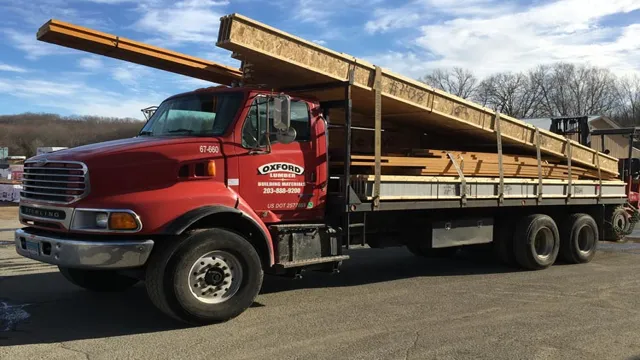Transporting 12 ft lumber can be a daunting task, especially if you don’t know how to do it properly. It’s important to transport them in a safe and secure manner to avoid accidents on the road. If you’re in the construction industry or simply need to transport lumber for your DIY project, this comprehensive guide will give you all the information you need to transport 12 ft lumber safely and efficiently.
When it comes to transporting 12 ft lumber, there are a few factors to consider. First, you need to determine the most suitable transportation mode for your needs. Depending on the distance you need to cover and the quantity of lumber you have, you can choose between using a pickup truck, flatbed trailer, or a box truck.
Each has its advantages and disadvantages, and we’ll take a closer look at them in this guide. Once you’ve chosen your transportation mode, you need to ensure that your lumber is properly secured. This involves using straps and chains to keep the lumber in place and prevent it from sliding or falling off the vehicle.
We’ll show you the best practices for securing lumber, so you can transport it with confidence. Finally, you need to be aware of the regulations surrounding the transportation of lumber. Depending on your location, there may be specific rules and regulations that you need to follow.
It’s important to be aware of these regulations to avoid penalties and fines. We’ll cover the basics of lumber transportation regulations, so you don’t get caught off guard. Whether you’re a seasoned professional or a DIY enthusiast, this comprehensive guide will teach you everything you need to know about transporting 12 ft lumber.
With the right knowledge and equipment, you can safely and efficiently transport lumber to your destination. So let’s get started!
Know the Regulations
If you’re planning to transport 12 ft lumber, it’s essential to know the regulations and guidelines to avoid any mishap. The first step is to determine the weight and the overall dimension of the load. It’s best to secure the lumber by covering it with a tarp to prevent damage while in transit.
You must also ensure that the lumber doesn’t exceed the maximum length allowed by law, as it can be dangerous to both you and other road users. Before leaving, double-check that you have all the required permits and documents, such as a vehicle insurance policy, driver’s license, and goods transport license. Also, make sure that the vehicle you’re using can handle the weight and size of the load.
Remember, safety is a top priority, and it’s crucial to abide by the rules and regulations to ensure a safe and smooth trip.
Research Local Transportation Laws
Researching local transportation laws is an important step in ensuring that you are driving safely and legally. It’s crucial to know the regulations in your area, including speed limits, traffic signs, and rules of the road. Failing to abide by these laws can lead to fines, points on your license, or even accidents.
Some of the most common laws include wearing a seatbelt, using turn signals, and driving under the influence. Additionally, it’s essential to know the laws regarding distracted driving, such as using your phone while driving. While many of these laws may seem like common sense, it’s important to research them to ensure that you are always operating within the legal boundaries.
Remember, driving is a privilege, and with that privilege comes the responsibility to obey local transportation laws to keep yourself and other drivers safe on the road.

Check Vehicle Capacity and Weight Limits
As a driver, it is important to be aware of vehicle capacity and weight limits to ensure safety on the road. Different types of vehicles have different weight regulations, and these limits are put in place to prevent accidents and damage to road surfaces. By knowing the regulations, you can avoid overloading your vehicle and potentially facing costly fines or accidents due to overload.
Additionally, understanding the weight limits of your vehicle can help you plan better for trips. For instance, if you are planning to transport heavy items, you need to determine the weight of each item and ensure that the total weight is within your vehicle’s weight limit. So, before hitting the road, check your vehicle’s capacity and weight limits and avoid unnecessary risks and hassle.
Secure Your Load
When transporting goods, it’s important to make sure your load is secure. Not only can an unsecured load cause damage to your cargo, but it can also pose a serious safety hazard to other drivers on the road. To ensure that your load is properly secured, it’s important to know the regulations in your area.
Depending on where you’re located, there may be specific rules and guidelines that you need to follow. For example, some areas require you to use specific types of tie-downs or have your load covered with a tarp. By taking the time to familiarize yourself with these regulations, you can avoid potential fines or accidents.
Additionally, it’s important to regularly check on your load during transportation to ensure that everything remains properly secured. Remember, a few extra minutes taken to properly secure your load can make all the difference in arriving at your destination safely and without incident.
Choosing the Right Vehicle
Transporting 12 ft lumber can be a bit of a challenge, especially if you don’t have the right vehicle. One of the best vehicle options for moving long and bulky items like this would be a pickup truck. With its large cargo bed, you can easily fit the 12 ft lumber without the risk of damaging other parts of the vehicle.
However, not all pickup trucks are created equal, and you should make sure to choose one with an appropriate bed length. Typically, a truck with a bed length of 6 ft or longer is perfect, but if the lumber is even longer, you may need to consider a flatbed trailer or tie the lumber securely to the top of the truck using roof racks. It’s also crucial to make sure that the lumber is well-secured and cannot move or shift during transport to avoid any accidents on the road.
With the right vehicle and proper securing techniques, transporting 12 ft lumber can be done safely and efficiently.
Consider Your Options (Pickup Truck, Flatbed, Trailer)
Purchasing a vehicle for hauling goods can be an overwhelming decision, but it is important to consider your options to choose the right one for your needs. Pickup trucks are a popular option for their versatility and ability to tow different types of loads. If you need to haul bulky items that don’t fit well in a truck bed or require more cargo space, consider a flatbed truck.
Flatbeds are excellent for transporting items like construction equipment, building materials, and large appliances. Another option is a trailer; they come in various sizes and can be hitched to a truck or even a car. Trailers work well for transporting recreational vehicles, boats, and animals.
It is crucial to assess your needs and budget before making a purchasing decision. Remember to factor in any additional equipment you may need, such as tie-downs, trailer hitches, and towing packages. By selecting the right vehicle for the job, you can ensure both safety and efficiency on the road.
Measure the Lumber and Vehicle
When it comes to choosing the right vehicle to transport your lumber, there are a few key factors to consider. The most important is the size of the load you plan to transport – you’ll need a vehicle that can accommodate both the length and weight of your lumber without being overloaded. It’s also important to consider the terrain you’ll be driving on, as well as any obstacles you may encounter along the way.
A sturdy pickup truck or flatbed trailer with a beefy suspension system is ideal for transporting heavy loads of lumber over rough terrain. If you’re transporting smaller loads, consider using a smaller, more fuel-efficient vehicle to save on expenses. Ultimately, the right vehicle for the job will depend on your specific needs and preferences.
Take the time to measure your lumber carefully and evaluate your transportation needs before choosing a vehicle to ensure a safe and successful transport.
Ensure the Vehicle is Safe for Transportation
When it comes to transporting goods, choosing the right vehicle is crucial for ensuring their safe delivery. Before choosing a vehicle, it’s important to consider the size and weight of your cargo. If you plan to transport large and bulky items, a truck or a van will be the ideal choice.
On the other hand, if you only have a few items to transport, a smaller vehicle such as a car or a hatchback may suffice. It’s also important to pay attention to the condition of the vehicle. Make sure that it’s regularly serviced and maintained to ensure that it’s roadworthy.
This will not only ensure the safe transportation of your goods but also help you avoid costly breakdowns and delays. Plus, you’ll have peace of mind knowing that you and your cargo are in safe hands. Choose a vehicle that meets your specific transportation needs, and you’ll be on the road to a successful delivery.
Pack and Load Lumber
If you need to transport 12 ft lumber, it’s important to take the necessary precautions to ensure both your safety and that of others on the road. First, gather all the necessary packing materials, like wrap, padding, and straps, to secure the wood and prevent damage. Next, load the lumber onto a flatbed trailer or truck bed in a way that evenly distributes the weight to prevent tipping or shifting while transporting.
To do this, place heavier pieces of wood towards the center and stack it no more than three high. Finally, use strong and durable straps to secure the lumber to the truck bed or trailer, checking periodically to make sure the load hasn’t shifted during transit. Remember to always drive carefully and follow local regulations, like using flags and warning lights if necessary.
By taking these steps, you can safely transport 12 ft lumber without any accidents.
Use the Right Straps and Ties
When it comes to packing and loading lumber, it’s essential to use the right straps and ties. Heavy-duty straps made from materials like nylon or polyester are ideal for securing larger pieces of lumber. Soft loops, which are often used in conjunction with straps, provide extra stability and prevent damage.
Tie-downs are also important for keeping lumber in place during transport. Ratchet straps, buckles, and cam straps are all effective options. It’s crucial to make sure ties are tight and secure, but not too tight as to damage the wood.
Using the right straps and ties not only keeps your lumber safe but also prevents accidents while in transit. So, always invest in quality straps and ties to ensure the safety of your load and yourself on the road.
Protect the Lumber with Padding
As you begin to load and transport your lumber, it’s essential to protect it from damage. One effective way to do this is by using padding. By cushioning your lumber, you’ll be able to prevent scratches, dents, and other types of damage that can occur during transportation.
There are several types of padding you can choose from, such as blankets, foam, or even airbags. Regardless of which type you use, ensure that it’s secured tightly on the lumber before transport. This will help prevent the padding from slipping or falling off during transit.
Protecting your lumber with padding is an important step in ensuring that it arrives at its destination in good condition. So, before hitting the road, take some time to consider what type of padding you’ll be using to keep your lumber safe.
Transport Lumber Safely
Transporting 12 ft lumber can be a challenging task, but with proper planning and safety measures, it can be done successfully. Start by making sure that the lumber is properly secured and cannot move around during transportation. Use sturdy nylon straps to secure the wood, making sure they are tightened and fastened correctly.
To avoid damage to the wood, place protective coverings such as blankets or tarps around the lumber. Remember to use a vehicle suitable for transporting long lumber; larger trucks or flatbed trailers are ideal for this task. Always obey traffic laws, drive within the speed limit, and give other vehicles plenty of space.
By following these safety measures, you can transport 12 ft lumber safely and efficiently.
Drive Slowly and Carefully
When it comes to transporting lumber, it’s important to prioritize safety above all else. One crucial aspect of ensuring a safe journey is to drive slowly and carefully. The weight and size of lumber can make it difficult to maneuver, which is why it’s essential to be cautious and avoid sudden movements.
By driving carefully, you’ll also be able to react quickly to any unexpected hazards on the road. Additionally, it’s important to secure the lumber properly to prevent it from shifting or falling off the vehicle. Loose lumber can cause accidents and pose a danger to other drivers on the road.
Remember, taking the time to transport lumber safely can prevent accidents and save lives. So, next time you’re transporting lumber, take it slow and make safety your top priority.
Keep a Safe Distance from Other Vehicles
When it comes to transporting lumber, safety should always be a top priority. One important aspect of safe transportation is to keep a safe distance from other vehicles. This not only reduces the risk of collision but also helps prevent accidents and damage to the lumber.
A good rule of thumb is to maintain a distance of at least one vehicle length for every 10 miles per hour you are driving. So, if you are traveling at 60 mph, you should keep a distance of at least six vehicle lengths. Additionally, make sure to secure the lumber properly to the vehicle to avoid it from slipping or falling during transit.
This will not only protect the lumber but also other motorists on the road. Always be aware of your surroundings and adjust your speed, distance, and handling accordingly to ensure safe and efficient transportation of lumber. By following these tips, you can transport lumber safely and confidently, ensuring that both the cargo and drivers are protected throughout the journey.
Check Your Load Frequently
When it comes to transporting lumber, safety should be your top priority. One of the easiest ways to ensure that you’re transporting your load safely is by checking it frequently. It’s not enough to load up your truck and hit the road without a second thought.
You need to be aware of how the weight of your lumber is affecting your vehicle’s handling and performance. One wrong move, and you could be facing a potentially deadly accident. That’s why it’s so important to check your load often to make sure that everything is secure and in place.
Whether you’re driving on smooth pavement or rough roads, always be on the lookout for any shifting or movement of your load. By doing this, you’ll be able to prevent unexpected accidents that could cost you precious time and money. Remember, the key to transporting lumber safely is by being vigilant and proactive, so don’t forget to give your load a quick check every once in a while.
Conclusion
In the immortal words of Paul Bunyan, ‘If you wanna move big lumber, you gotta be a big man.’ Just kidding! In reality, transporting 12 ft lumber doesn’t have to be a Herculean task. With the right tools and a little know-how, you can get the job done easily and efficiently.
Remember to measure your vehicle, secure the lumber properly, and watch out for low overhead obstacles. And if all else fails, well, there’s always the option of just chopping it in half!”
FAQs
What is the maximum length of lumber that can be transported?
The maximum length of lumber that can be transported legally is 12 feet in most states.
Can lumber be transported on a regular pickup truck?
Yes, lumber can be transported on a regular pickup truck as long as it does not exceed the length limit set by the state.
Is it legal to transport lumber on the roof of a car?
It depends on the state laws and the size of the lumber. In some states, it is legal to transport lumber on the roof of a car as long as it does not pose a safety risk to other drivers.
What is the best way to secure lumber during transportation?
The best way to secure lumber during transportation is to use tie-downs, such as ratchet straps or bungee cords, to ensure that the lumber does not shift or fall off the vehicle.
Can lumber be transported on a trailer?
Yes, lumber can be transported on a trailer as long as the trailer is equipped to handle the weight and length of the lumber.
Do I need a special license to transport lumber?
No, you do not need a special license to transport lumber as long as you are driving a vehicle that is legally permitted to transport the length and weight of the lumber.
Can I transport lumber on public roads without a permit?
It depends on the size and weight of the lumber. In some states, a permit is required for oversized or overweight loads, including lumber. Check with your state’s department of transportation to ensure compliance.






